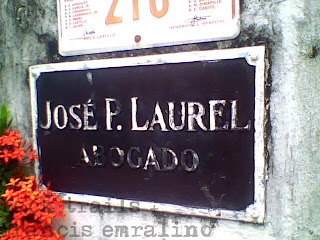 * a map showing some of the barangays of Tanauan; I took this one to have a general idea of the distance of Mabini’s Shrine from the Poblacion
* a map showing some of the barangays of Tanauan; I took this one to have a general idea of the distance of Mabini’s Shrine from the Poblacion * behold, the church of Tanauan
* behold, the church of Tanauan * if one doe not know he is looking at the entrance of Tanauan, he would think this is part of a European church; indeed, this is looks so elegant; sorry if I cannot make an architectural description, I am yet to equip myself with a bit of knowledge about that
* if one doe not know he is looking at the entrance of Tanauan, he would think this is part of a European church; indeed, this is looks so elegant; sorry if I cannot make an architectural description, I am yet to equip myself with a bit of knowledge about that  * view inside the church
* view inside the church * the old Tanauan town hall, now the city’s museum
* the old Tanauan town hall, now the city’s museum  * a monument for Mabini; notice that he is standing here
* a monument for Mabini; notice that he is standing here * Abogado!
* Abogado!  * a view of the house of Jose P. Laurel; I have always wondered why it is always close whenever I go there; one bad experience there was when we almost became victims of the premises’ attack dogs!
* a view of the house of Jose P. Laurel; I have always wondered why it is always close whenever I go there; one bad experience there was when we almost became victims of the premises’ attack dogs!The names Apolinario Mabini and Jose Laurel are always associated with Tanauan. But literature-wise, I always recall that unforgettable character in El Filibuterismo by Jose Rizal.
He was Placido Penitente. As I write this, I am looking down a Virgilio Almario edition of the El Fili. The chapter about him relays his desire to go back home in Tanauan and stop schooling. A certain Padre Valerio was mentioned and at the back, a note was made about him. He was, in fact, a real person.
Padre Valerio Malabanan was a native of Lipa, Batangas and was a graduate of UST. He became a parish priest of Lipa but chose the vocation of teaching. In 1865, he opened a school in Tanauan named Colegio del Padre Valerio. And, incidentally, Apolinario Mabini enrolled in his school. I wonder if Rizal was somehow making a sketch of Mabini through Penitente. Although Tanauan is already gearing up for modernization, it is still good to see old houses still standing around the city proper.
I am yet to visit a new church built along the main highway which houses a certain Our Lady.
 * three-storied tower-like part of a house; the lower ground houses a Pantoja store
* three-storied tower-like part of a house; the lower ground houses a Pantoja store * small yet sooo beautiful
* small yet sooo beautiful * Gov. Modesto Castillo Memorial Cultural Center; this one will open soon
* Gov. Modesto Castillo Memorial Cultural Center; this one will open soon * found along the street leading to the church
* found along the street leading to the church * one old house found along one of the busiest thoroughfares of Tanauan
* one old house found along one of the busiest thoroughfares of Tanauan * an entrance to the municipal cemetery; shot on the way back from the Mabini Shrine
* an entrance to the municipal cemetery; shot on the way back from the Mabini ShrineThe Tanauan Church
The administration of the church of Tanauan was accepted by the Augustinians on May 5, 1584. Its first parish priest was Fr. Antonio Roxas. The first church which was made of wood was first erected along the shores of Lake Bombon (Taal Lake) in the year 1690. The concrete church was later erected in 1732. In 1754, Taal Volcano erupted submerging virtually everything along the lake’s shores including the church. The reconstruction of the church was led by Fr. Jose Diaz in 1881. World War II came and in the year 1944, the church was completely destroyed. Reconstructions were made in 1946 by a certain Monsignor Mariño.




































